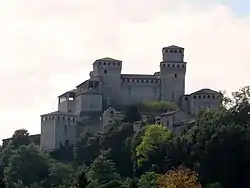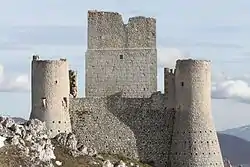Ladyhawke (film)
Ladyhawke is a 1985 American medieval dark fantasy film directed and produced by Richard Donner and starring Matthew Broderick, Rutger Hauer, and Michelle Pfeiffer. The story is about a young thief who unwillingly gets involved with a warrior and his lady who are hunted by the Bishop of Aquila. As he comes to know about the couple's past and secret, he finds himself determined to help them overcome the bishop's oppressions, both in arms and in the form of a demonic curse.
| Ladyhawke | |
|---|---|
 Theatrical release poster | |
| Directed by | Richard Donner |
| Produced by |
|
| Screenplay by |
|
| Story by | Edward Khmara |
| Starring | |
| Music by | Andrew Powell |
| Cinematography | Vittorio Storaro |
| Edited by | Stuart Baird |
Production company | |
| Distributed by |
|
Release date |
|
Running time | 121 minutes |
| Country | United States |
| Language | English |
| Budget | $20 million |
| Box office | $18.4 million |
Plot
In medieval Italy, Phillipe Gaston, a thief known as "The Mouse", escapes from the Bishop of Aquila's dungeons right before execution. He is recaptured at an inn by the Bishop's guards, led by Captain Marquet. However, the former captain, Etienne Navarre, shows up and defeats Marquet and the guards. He rides off with Phillipe while his hawk scatters other guards along the way.
Navarre, accompanied by Phillipe, stay the night at a farmer's barn. Phillipe narrowly escapes from the farmer's attempt on his life when an enormous black wolf emerges and kills the farmer. Navarre has disappeared from the barn. A mysterious young woman appears and accompanies the wolf.
Navarre reveals his intention to kill the Bishop and asks Phillipe to help him get inside Aquila. Phillipe refuses to help him, and Navarre ties the unwilling Phillipe to a tree that night. Phillipe escapes by tricking the mysterious woman into untying him, but he is soon captured by the Bishop's guards. The guards set up an ambush to capture Navarre as well.
In the ambush, Navarre and his hawk are each hit by a crossbow bolt, yet he manages to defeat the Bishop's guards and save Phillipe. The wounded Navarre makes Phillipe take the dying hawk and ride his horse to a monk's (Imperius's) ruined castle for help. The hawk is sequestered in a room, but a curious Phillipe picks the lock and finds the mysterious woman inside, her chest also struck with a bolt. After tending to her wound, Imperius explains that she is Isabeau of Anjou. She and Navarre were cursed by the Bishop because she refused the Bishop's love, and their secret vows were leaked to the Bishop by Imperius in a drunken confession. The Satanic curse turns Isabeau into a hawk by day and Navarre a wolf by night so that despite being always together, they are eternally apart.
When Navarre catches up in the morning, Imperius tells him that the curse can be broken if the couple face the Bishop together as humans on "a day without a night and a night without a day". Navarre dismisses Imperius as an old drunk, and continues his way to Aquila intent on simply killing the Bishop. Phillipe decides to leave with Navarre and "Ladyhawke".
After Isabeau's perilous encounter with Cezar the wolf trapper, and Phillipe saving the transformed Navarre-wolf from freezing in an icy river, Phillipe succeeds in persuading the couple to break the curse. At night, Imperius and Isabeau smuggle the Navarre-wolf into Aquila while Phillipe dives into the sewers to get inside the cathedral.
Unable to see any divine sign on the day that he and Isabeau are to appear in the flesh together, Navarre reverts to his original plan to kill the Bishop. He convinces Imperius to euthanize the hawk should the cathedral bells ring, which would mean he had failed.
Phillipe infiltrates the cathedral and unlocks the doors. Navarre rides in and duels with Marquet. Amid the bout, Navarre sees a solar eclipse through a high window and realizes the curse really can be broken. He tries to get back to Imperius but fails to keep the guards from ringing the bell. Despairing that Imperius has killed Isabeau, he continues his fight and eventually kills Marquet.
As Navarre is about to kill the Bishop, Isabeau enters the cathedral and stops him. Together they face the Bishop and break the curse. The maddened Bishop tries to kill Isabeau, only to die by Navarre's sword instead. Isabeau and Navarre finally embrace in joy.
Cast
- Matthew Broderick as Phillipe Gaston, a young thief known as "The Mouse".
- Rutger Hauer as Etienne of Navarre, the former Captain of the Guard of Aquila who, with Isabeau, is hunted by the Bishop.
- Akeela, Kollchek, Levi, and Sasha—a quartet of melanistic Siberian wolves—as Etienne's lupine form.[1]:141
- Michelle Pfeiffer as Isabeau of Anjou, the Comte d'Anjou's daughter, who, with Etienne, is hunted by the Bishop.
- Gift (c.1979–2 or 3 Dec 2014)[2][3] and Ladyhawke (d. May 2007) (named Spike II until 2000)[4]—two female red-tailed hawks—as Isabeau's avian form.
- Leo McKern as Imperius, an old monk living in a ruined castle who used to serve the Bishop.
- John Wood as the Bishop of Aquila, who is obsessed with killing Etienne and capturing Isabeau.
- Ken Hutchison as Captain Marquet, the current Captain of the Guard.
- Alfred Molina as Cezar, a wolf trapper who serves the Bishop.
- Giancarlo Prete as Fornac, a higher ranking guard.
- Loris Loddi as Jehan, a higher ranking guard.
Production


Richard Donner had attempted to get the film financed for a number of years and came close to making it twice, once in England and once in Czechoslovakia. He eventually got the project up at Warners and Fox, where it was green-lit by Alan Ladd Jr. Originally, Kurt Russell was cast as the male lead alongside Michelle Pfeiffer. The role of the pickpocket was offered to Sean Penn and then Dustin Hoffman, before Donner decided to go with Matthew Broderick. Eventually, Russell pulled out during rehearsals, and Rutger Hauer was chosen to replace him.[5]
Filming locations
Ladyhawke was filmed in Italy; the appennine meadow of Campo Imperatore in Abruzzo served as a prominent exterior location, while the monk scene was filmed at Rocca Calascio, a ruined fortress on top of a mountain, not far from real-world L'Aquila. In the region of Emilia-Romagna, the town of Castell'Arquato in the province of Piacenza and castle of Torrechiara in the province of Parma were also featured. Other Italian locations used include Soncino in the Lombardia region, Belluno in the Veneto region, and the Lazio region around Viterbo.[6][7]
Soundtrack
| Review scores | |
|---|---|
| Source | Rating |
| Allmusic | |
The film's score was composed by Andrew Powell and produced by Alan Parsons. Richard Donner stated that he was listening to The Alan Parsons Project (on which Powell collaborated) while scouting for locations, and became unable to separate his visual ideas from the music. Powell combined traditional orchestral music and Gregorian chants with contemporary progressive rock-infused material. It has been cited as the most memorable example of the growing trend among 1980s fantasy films of abandoning the lush orchestral scores of composers such as John Williams and James Horner in favor of a modern pop/rock sound.[8] The soundtrack album was released in 1985 and re-released with additional tracks in 1995. On February 10, 2015, a 2-disc set was released by La-La Land Records; it includes previously unreleased music and bonus tracks, and is limited to 3,000 units.[9]
Critical reception
Ladyhawke has a rating of 67% on Rotten Tomatoes, based on 24 critics' reviews. The site's consensus states: "There's pacing problems, but Ladyhawke has an undeniable romantic sweep that's stronger than most fantasy epics of its ilk."[10]
Vincent Canby in The New York Times called the film "divided against itself," and went on to say that "scenes of high adventure or of visual splendor... are spliced between other scenes with dialogue of a banality that recalls the famous Tony Curtis line, 'Yondah lies my faddah's castle.'"[11] Time Out called it "all rather facile sword-and-sorcery stuff, of course, but at times very funny... and always beautifully photographed."[12] Variety described the film as a "very likeable, very well-made fairytale... worthwhile for its extremely authentic look alone."[13] Siskel & Ebert both gave the film positive "thumbs up" reviews on their syndicated television show and thought Ladyhawke was beautifully filmed with the potential to achieve lasting success as a classic in its genre.[14] Siskel's only major complaint was that Broderick's role was almost anachronistic in his 1980s-style jokes, while Ebert felt Broderick's comedic elements were fitting.
The New York Times singled out Matthew Broderick's skill in coming "very close to transforming contemporary wisecracks – particularly, his asides to God – into a more ageless kind of comedy," and said of Michelle Pfeiffer that her "presence, both ethereal and erotic, is so vivid that even when she's represented as a hawk, she still seems to be on the screen."[11] Variety praised the casting of the lead actors, considering Pfeiffer "perfect as the enchanting beauty."[13] Time Out called Rutger Hauer "camp" and Pfeiffer "decorative."[12]
Awards and nominations
Ladyhawke was nominated for two Academy Awards, in the categories of Best Sound Effects Editing (Bob Henderson and Alan Murray) and Best Sound (Les Fresholtz, Dick Alexander, Vern Poore and Bud Alper), winning neither.[15] It won a Saturn Award for Best Fantasy Film, and was nominated in the categories of Best Actress (Michelle Pfeiffer) and Best Music (Andrew Powell).[16]
See also
References
- Senn, Bryan (2017). "Ladyhawke". The Werewolf Filmography: 300+ Movies. MacFarland. pp. 140–141.
- Wildlife Images Rehabilitation & Education Center (3 Dec 2014). "Today marks the passing of one of our most famous animals …". Facebook. Retrieved 24 Jul 2019.
- "Gift—The Red-Tailed Hawk". Rutger Hauer Official Website. Dec 2014. Retrieved 24 Jul 2019.
- "A Special Star" (PDF). Florida Naturalist. Audubon of Florida. Summer 2007. p. 13. Retrieved 24 Jul 2019.
- Tom Mankiewicz, My Life as a Mankiewicz p 260-265
- "Ladyhawke Filming Locations". fast-rewind.com.
- "Rocca Calascio, l'imponente castello in Abruzzo dove girarono i film Ladyhawke e Il Nome della Rosa" (in Italian)..
- "Ladyhawke - Soundtrack". filmtracks.com.
- "film music - movie music- film score - Ladyhawke - Andrew Powell - Limited Edition". www.lalalandrecords.com. Archived from the original on 10 December 2017. Retrieved 8 October 2017.
- "Ladyhawke (1985)". Rotten Tomatoes.
- Vincent Canby (April 12, 1985). "FILM: 'LADYHAWKE,' A MEDIEVAL TALE". nytimes.com.
- DPe. "Ladyhawke (1985), Review by Time Out". timeout.com. Archived from the original on 2008-02-01.
- Variety Staff (December 31, 1984). "Ladyhawke". variety.com.
- https://www.youtube.com/watch?v=bbjYFtSUKZY
- "The 58th Academy Awards (1986) Nominees and Winners". oscars.org. Retrieved 2011-10-16.
- "Ladyhawke - Awards". imdb.com.
External links
| Wikiquote has quotations related to: Ladyhawke |